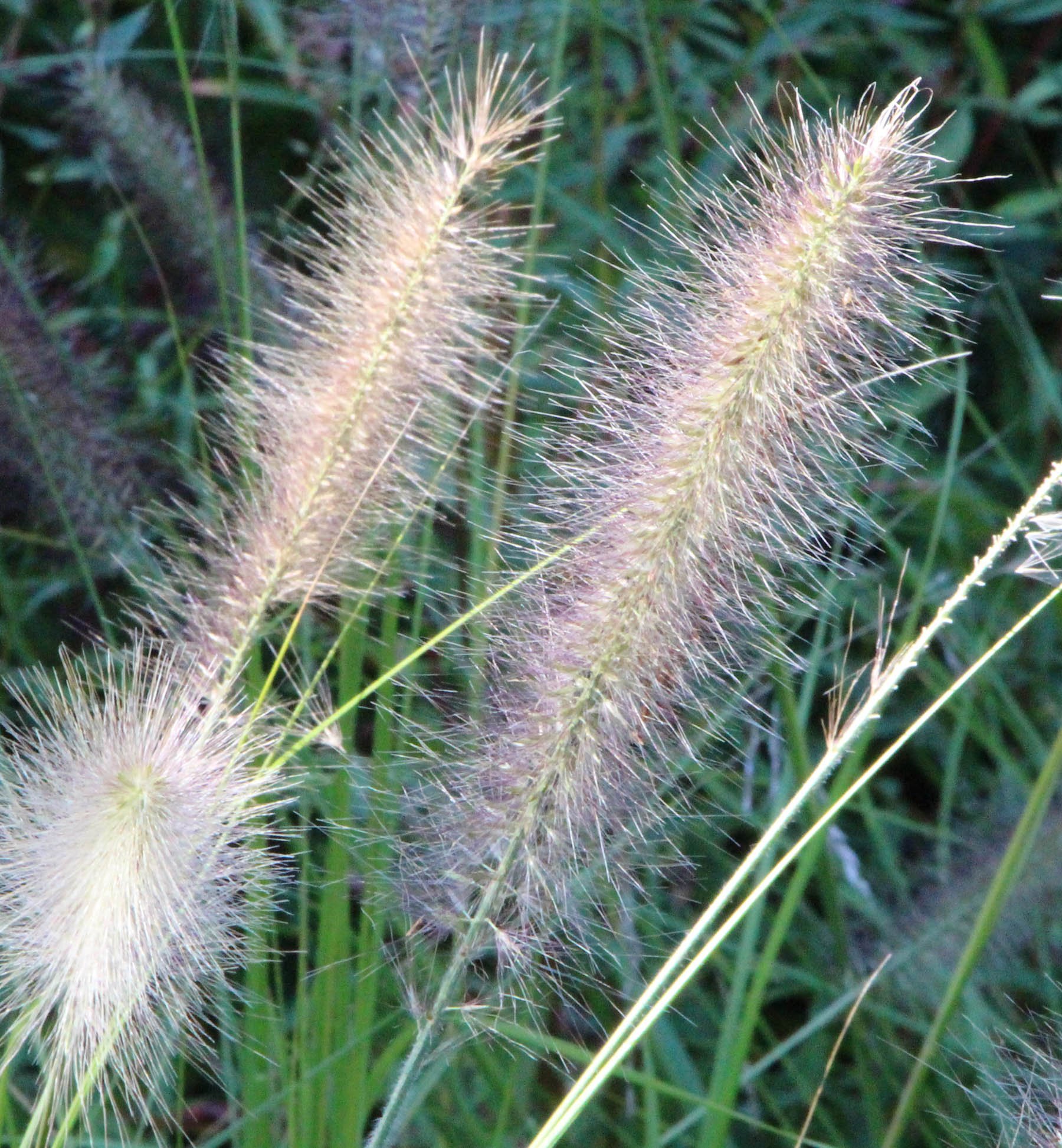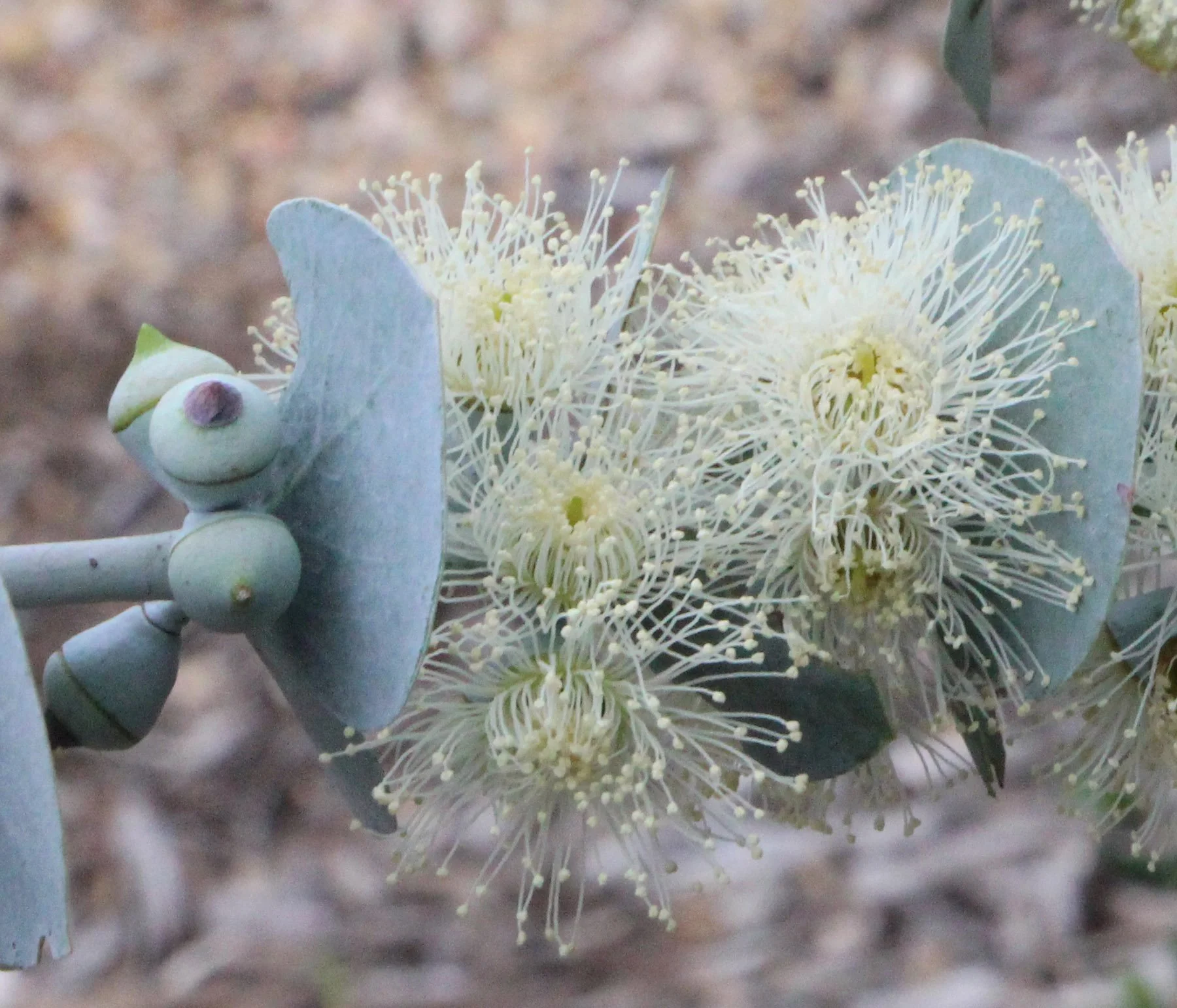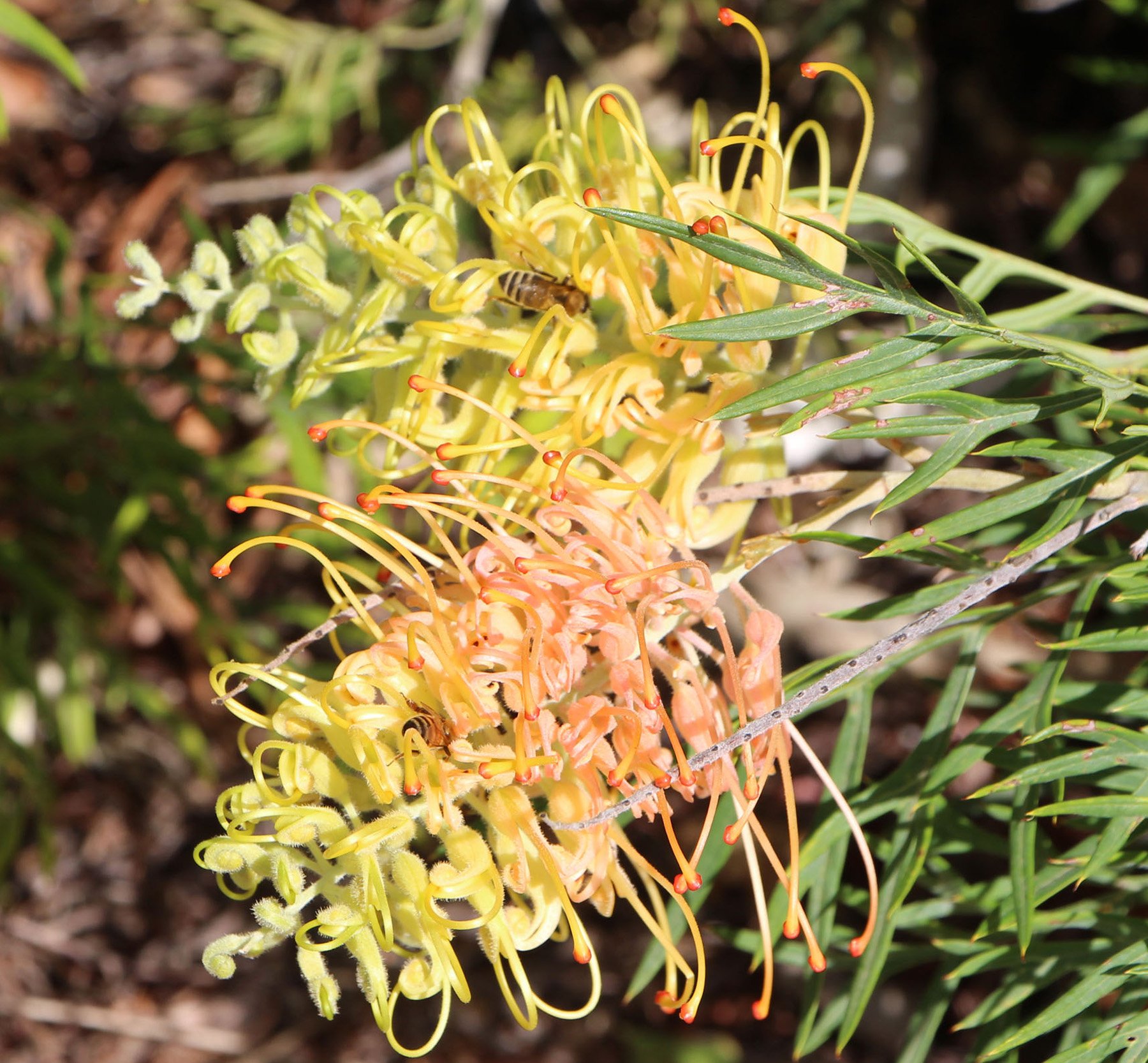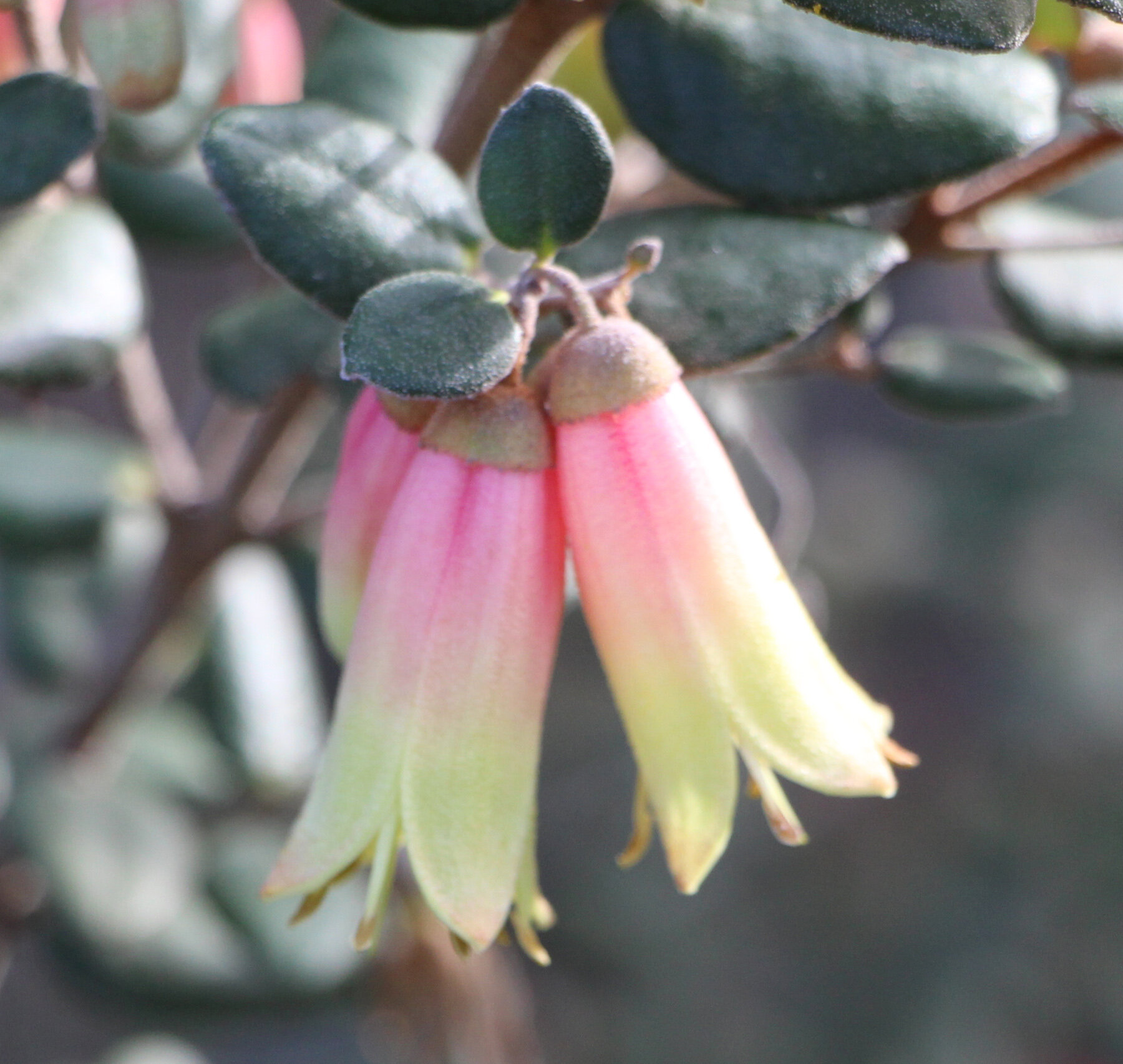March
A few plants that are in bloom in our garden in March
Click on any image to enlarge and scroll though all the images for each week.
Correa pulchella ‘St. Andrews White’
24 March 2025
Starting from the top left:
Banksia paludosa compact
We planted this banksia, 20-30cm high x 3m wide, with attractive green foliage in whorls with silvery undersides, and cylindrical yellow banksia flowers over a long period, in May 2008. The new ginger-coloured cones are a delightful feature of this plant, which is native to central and southeastern NSW. Removed February 2020 as was severely browned off.
Correa ‘Canberra Bells’
We have tried seven specimens of this shrub, which grows to to 1m x 1m, with oval green foliage and red and cream bell flowers from late summer to winter. The plants in the ground have not done as well for us as one we planted in a pot in March 2017. The plant in the pot blooms prolifically over a long period. Perhaps mercifully the plants in the ground were squashed flat by the fall of a pine in July 2016.
Crowea saligna ‘Large Flower’
We planted three of these small shrubs in pots, 80cm high x 60cm wide, with large pink flowers and aromatic foliage. Native bees and butterflies are attracted to this plant. However, so are our resident hares, who eat off all the flowers.
Grevillea pimelioides
We planted this erect shrub, 2.5m high, with red tipped, hard yellow flowers in a pot in September 2010. This plant is native to the Helena and Canning River regions southeast of Perth, WA. We transplanted our specimen to a large pot in February 2012 and cut it back quite severely. Our original plant died in December 2016 and we planted another in July 2020 which has been vigorously trimmed by rosellas and visited by many Eastern Spinebills.
Hakea clavata
We have planted two of these shrubs, 1.5m high x 2.5m wide, with succulent like leaves and pale pink to white flowers, in March 2012 and November 2019. The foliage is unusual and a feature of the plant. Our first specimen, planted in March 2012, was hit by the frost in October of the same year and died. The second one we planted in pot in November 2019 and it is growing well so far and flowered for the first time in October 2021. This plant is native to the Esperance area of WA and is adapted to harsh conditions. Terrific all-over flowering in March-April 2025.
Pandorea jasminoides ‘Lady Di’
We planted this dense, vigorous climber, long-blooming, with many delicate white trumpet flowers with golden throats and a sweet fragrance, in January 2007.
10 March 2025
Starting at the top left:
Callistemon ‘Carnival Cerise Pink’
We planted four of these Callistemon citrinus cultivars, 1.2m high and wide, with pink bottebrush flowers and pink new growth on lemon scented green foliage, in 2022 and 2023. Best grown in full sun or part shade in free draining soil.
Correa ‘Little Pink Belle’
We planted two of these hybrid plants, 80cm high and wide, with aromatic foliage and many green tipped pink bell flowers, in 2024. These are planted in part shade.
Eremophila hygrophana
We have planted four of these low spreading shrubs, 0.75m high x 1m wide with dull grey or grey-green linear leaves, which have a dense cover of very tiny hairs, and blue to purple flowers, in 2010, 2019 and 2021. The name means change of colour which refers to the colour of the flower as it dries. This species is native to arid regions of central WA, northern SA and southern NT and needs full sun or filtered shade in an open position with good air movement and is tolerant of light frost.
Eremophila youngii
We have planted two of these upright shrubs, 1-2m high x 0.6-1m wide, with attractive grey foliage and tubular pink flowers, in 2010 and 2012. This plant is native to central WA. One died in April 2021, but the other is now over 2m high and blooms often.
Grevillea ‘Lady O’
Grevillea ‘Lady O’ is Ben’s favourite plant in our garden because it always looks healthy and never stops flowering. This plant is a hybrid between a Grevillea victoriae hybrid and Grevillea rhyolitica and has light green foliage and prolific red flowers. ‘Lady O’ was bred at Bywong Nursery and named after Peter Ollerenshaw’s mother. The bushy plant grows to 2m high and wide. We planted our first ‘Lady O’ in April 2004 and have planted 13 since then over the five years to 2009. This plant is a fabulous performer in our garden.
Grevillea sericea ssp. sericea pink form
We planted this evergreen shrub, 1-2m high x 2m wide, with many dainty pink flowers in February 2022. This plant prefers a partly shaded site, but will tolerate full sun and can withstand dry periods and moderate frost. Native to the area around Sydney.
11 March 2024
Starting from the top left:
Banksia ericifolia ‘Red Rover’
We planted one of these plants in our large rockery in November 2006. This plant has grown much larger than its advertised 1..8m high x 1.2m wide, more like 3m high x 6m wide, with bright red flower spikes and fresh green needle foliage. Our plant began flowering in May 2010, but did not show bright red brushes until it became more mature.
Correa ‘Candy Pink’
We planted three of these dense rounded hardy shrubs, 1.5m high x 2m wide, with bronze new growth and pink starry flowers in April 2021. These plants do best in dry to moist well drained soils in part or full sun.
Eremophila maculata ‘Passionate Lady’
We planted two of these evergreen compact shrubs, 1m high x 1m wide, with deep pink blooms, in February 2019, and another in March 2022. Apart from being eaten by our resident hare in October 2020, these plants are thriving. Ian Tranter says that this plant is very similar to E. ‘Meringur Crimson’. Unlike many of our eremophilas, these plants have loved the extra rain of a La Nina year, 2021-2.
Grevillea ‘Pink Profusion’
We planted this compact bushy shrub, 1.5m high and wide, with divided foliage and pinky-red cylindrical flowers over a long period, in November 2023. This plant prefers full sun in well drained soils and is tolerant of light frosts. Bred by King’s Park.
Hibiscus heterophyllus ‘Lutea’
We planted this open shrub, 4m high x 3m wide, with lobed leaves and large yellow flowers with maroon centres, in a pot, in March 2022. This plant needs well drained soils, is tolerant of light shade, and must be protected from frost.
Xerochrysum bracteatum 'Dargan Hill Monarch'
We have planted a dozen of these plants, 0.8m high x 1.5m wide, with large greyish leaves and very large yellow paper daisies, in October 2022. They need a well drained sunny position and are very showy.
27 March 2023
Starting from the top left:
Banksia paludosa ‘Little Pal’
We planted this hardy dwarf shrub, 0.75m high x 1.2m wide, with bird attracting ginger flowers, in 2008. ‘Little Pal’ can be planted in full sun or partly shaded positions, preferring well drained soils.
Banksia seminuda – River Banksia
We planted this fast-growing erect tree, 5-15m high by 2-4m wide, with attractive dark green foliage, silver underneath, and large red and gold flowers in August 2016. Ben grew our plant from seed and the tree has now reached 5m high and 3m wide and is flowering with more than 50 cones in March 2023. This plant is native to southwestern WA.
Banksia ‘Yellow Wing’
We planted nine of these banksia hybrids in 2006, Banksia ‘Giant Candles’ x B. spinulosa (Carnarvon Gold) ‘Birdwire’. They form a rounded shrub, 1.5-1.8m x 1.5x1.8m wide, with fine dense foliage and many orange nectar-rich flowers. The flower spikes are held well above the foliage which attracts a range of nectar eating birds, and parrots love their seed.
Eremophila arbuscula
Name means small tree. We planted this tree, to 11m high, with narrow silver-grey drooping leaves and sweetly scented, creamy yellow flowers with yellow or orange spots, in March 2014. This tree is native to southern Queensland where it grows on stony or loamy soils in full sun.. A magnificent plant with gnarled appearance even at an early age.
Eremophila ‘Yanna Road’
We have planted three of these evergreen shrubs, 1m high and wide, with narrow grey foliage and pink tubular flowers, in 2016-7. These plants prefer a sunny open position in well drained soil but are a bit sensitive to frost.
Eucalyptus pulverulenta ‘Baby Blue’
We planted this tree, 3-6m high, with silver heart shaped foliage and clusters of cream flowers, in September 2018. This plant needs well drained soil in full sun, is frost tolerant and responds well to pruning. One half of little tree was broken off in December 2019 and was also eaten by some invisible attacker in June 2020 with not many viable leaves remaining. The tree has since leafed out again and flowered for the first time in March 2022.
13 March 2023
Starting from the top left:
Adenanthos meissneri – Prostrate Woollybush
We planted three of these low growing spreading shrubs 1.5m high x 2m wide, with grey green hairy foliage and small red tubular flowers, in February 2011. These do get somewhat frost damaged in winter, even though they are growing under Grevillea insignis, which gives them some protection. This plant is native to southwestern WA.
Banksia ‘Bird Song’
We planted three of these hybrids, B. spinulosa ‘dwarf’ x ericifolia ‘Golden Girl’ in August 2013. These are hardy banksias, height 1.5m x 1.5m, which flower prolifically throughout autumn and winter with shiny green foliage and orange spikes of flower. Honeyeaters love this plant.
Banksia ericifolia ‘Red Rover’
We planted one of these plants in our large rockery in November 2006. This plant has grown much larger than its advertised 1..8m high x 1.2m wide, more like 3m high x 6m wide, with bright red flower spikes and fresh green needle foliage. Our plant began flowering in May 2010, but did not show bright red brushes until it became more mature.
Banksia media ‘Copper Candles’
We planted this cultivar, 1.5m high x 1.5m wide, with golden yellow flowers with brown tips and glossy green leaves, in September 2019. First flowers 1/22
Banksia pulchella – Teasel Banksia (grafted)
We planted a grafted specimen of this plant in April 2009. The species name is from the Latin for pretty. The shrub grows to 1m high and flowers with brownish-yellow teasel flowers with unusual grey, knobbly fruiting cones. Our plant has flowered reliably since April 2010. This plant is native to the south coast of Western Australia, near Esperance. The type collection was by Robert Brown in January 1802, Lucky Bay, WA.
Correa reflexa x decumbens ‘Redex’
We have planted thirty of these narrow shrubs, 1m high x 0.8m wide, with small, tough, shiny crinkled leaves and red and yellow bird attracting flowers, from 2004-21. This cultivar arose in Kangaroo Island SA, and is thought to be a natural hybrid of Correa reflexa and C. decumbens. We have lost come over the years, but this plant is very floriferous and frost resistant and remains a favourite in our garden.
28 March 2022
Banksia marginata miniature
We planted this shrub with masses of small yellow flowers and dark green leaves with silver undersides, very frost hardy, in June 2007.
Correa glabra pink and cream
We planted three of these plants, 1m high and wide, with shiny green leaves and pink and cream bell flowers, in March 2017. This plant is native to NSW, Queensland, Victoria and South Australia.
Correa ‘Mallee Pink’
We planted four ‘Mallee Pink’ , 1.5m high x 2m wide, a winter flowering plant with pink bell flowers, in May 2005 and another three in May 2008. Only one survives, but it is a terrific plant with many flowers over a long period.
Correa reflexa x decumbens ‘Redex’
We have planted thirty of these narrow shrubs, 1m high x 0.8m wide, with small, tough, shiny crinkled leaves and red and yellow bird attracting flowers, from 2004-21. This cultivar arose in Kangaroo Island SA, and is thought to be a natural hybrid of Correa reflexa and C. decumbens. We have lost some over the years, but this plant is very floriferous and frost resistant and remains a favourite in our garden.
Eremophila mackinlayii subsp. spathulata
This shrub, 1.5m x 1.5m, with grey green leaves and large blue-purple flowers is one of our most reliable bloomers in the garden. We planted one in October 2017 and another in May 2019. The first planted has grown to its full size, is dense and well shaped and very rarely out of flower.
Eremophila oldfieldii ssp. angustifolia x E. oppositifolia ‘Piccaninny Dawn’
We have planted three of these compact shrubs, 3m high x 3m wide, with dark grey leaves and rose pink flowers, in 2011, 2018 and 2020. This plant will grow in a variety of soils, is drought tolerant and is somewhat tolerant of frost. Our first plant died after -6 deg. C. frost in June 2012. We have placed the other two under more overhead protection and they are flowering well.
21 March 2022
Banksia pulchella – Teasel Banksia (grafted)
We planted a grafted specimen of this plant in April 2009. The species name is from the Latin for pretty. The shrub grows to 1m high and flowers with brownish-yellow teasel flowers with unusual grey, knobbly fruiting cones. Our plant has flowered reliably since April 2010. This plant is native to the south coast of Western Australia, near Esperance. The type collection was by Robert Brown in January 1802, Lucky Bay, WA.
Banksia ericifolia ‘Red Rover’
We planted one of these plants in our large rockery in November 2006. This plant has grown much larger than its advertised 1..8m high x 1.2m wide, more like 3m high x 6m wide, with bright red flower spikes and fresh green needle foliage. Our plant began flowering in May 2010, but did not show bright red brushes until it became more mature.
Brachyscome ‘Mauve Bliss’
We have planted eleven of these compact fine foliaged plants, 15cm, high x 30cm wide, with large mauve daisy flowers, from 2012-2015. They have been damaged by the frost more than ‘Magenta Bliss’ and very few remain.
Correa ‘Summer Belle’
We have planted five of these spreading shrubs, 1m high x 1.5m wide, with shiny dark green leaves and pink flowers with green tips. This plant arose as a garden seedling from Neil Marriott of Stawell in Victoria.
Pennisetum alopecuroides – Swamp Foxtail
We planted 50 of these tussock forming grasses with narrow arching leaves and feathery purplish flower heads on erect stems to 1m high. These plants are hardy in most soils, even those not well drained, and are best grown in full sun. We removed many of these in the garden, but they have persisted around our water features. We cut them right back each year for better growth. These plants are native to both Australia and Asia.
Syzygium australe
We planted three Syzygium australe in December 2008. These shrubs grow to 3m high and have attractive red new growth, fluffy white flowers over a long period and shiny pink-purple fruits. Our three have been regularly blasted by frost and lose all their leaves during winter, but regenerate when the weather warms up. This plant is native to Queensland and New South Wales, northwards from Batemans Bay.
14 March 2022
Banksia marginata
We planted three Banksia marginata in March 2017, which were grown from seed from specimens on Mt. Wellington, Tasmania.
Correa ‘Catie Bec’
We have planted six of these shrubs, 1m x 1.5m wide, with pretty pink flowers, over the period 2018-21. In our garden they need some overhead protection.
Eremophila oldfieldii
We planted this shrub, 2m high x 2m wide, with dark green leaves and dark orange flowers, in November 2011. This eremophila is named after Angus Oldfield, English botanist This plant is native to central and southern WA.
Eucalyptus pulverulenta
We planted this twisted tree, height to 8m, with silver-grey stem-clasping foliage and white flowers, in October 2014. This plant is native to the area between Bathurst and Bombala, NSW.
Grevillea x semperflorens
Grevillea x semperflorens’ (photos above) was sold to us as ‘Mallee Dawn’ but Peter Olde quickly identified it for us as x semperflorens’, one of the earliest hybrid grevilleas ever produced. This cultivar was developed in England and was first formally described in 1937 by F.E. Briggs in The Journal of the Royal Horticultural Society of London as Grevillea semperflorens. We planted three in September 2007 and quickly realised our mistake as they grew much too large for their position and had to be removed. We planted another in February 2019 in a better spot, but this one disappeared for a few months, but has now reappeared and is flowering. The flowers are a lovely soft apricot colour.
Scaevola ‘Sitting Pretty’
We planted three of this Scaevola humilis selection, bred by Peter Abell, with pink flowers and a spreading habit to 1m wide, in February 2015. The pink flowers are attractive over a long period, but our three plants are not very vigorous.
7 March 2022
Starting from the top left:
Acacia cremiflora
We planted three of these rounded shrubs, 1-1.5m high x 2m wide, with green circular foliage on arching branches and cream flowers in 2016-17. These plants bloom at least three times a year and their foliage, dark seed pods and umbrella shape is pleasing at all times of the year. This plant is native to central NSW, near Orange.
Alyogyne huegelii ‘Misty’
We planted three of these shrubs with attractive bluish foliage and many lilac flowers with burgundy centres in December 2018. These plants bloom very generously over several months.
Banksia marginata
We planted six specimens of our local banksia, Banksia marginata or Silver Banksia in 2003. These grew well and produced attractive yellow flowers with plenty of nectar for the birds. In fact, Yellow-Tailed Black Cockatoos quietly attacked a couple of trees and damaged them extensively. The silver-backed foliage as it moves in the wind has been a valued asset. All but one have now been removed. The remaining Silver Banksia droops over our lily pond and remains a favourite tree for small birds. This plant is native to southeastern Australia, including Tasmania. We planted three Banksia marginata in March 2017, which were grown from seed from specimens on Mt. Wellington, Tasmania.
Correa ‘Canberra Bells’
We have tried seven specimens of this shrub, which grows to to 1m x 1m, with oval green foliage and red and cream bell flowers from late summer to winter. The plants in the ground have not done as well for us as one we planted in a pot in March 2017. The plant in the pot blooms prolifically over a long period. Perhaps mercifully the plants in the ground were squashed flat by the fall of a pine in July 2016.
Correa ‘Jetty Red’
We have planted six of this selected compact form of C. reflexa., with striking red bell shaped flowers, three in March 2016 and three in February 2021. Unfortunately only one remains of the first planting and all three correas died in the first week after the second planting. However, the one that remains is healthy and has beautiful flowers.
Grevillea ‘Peaches and Cream’
This shrub is a slightly frost sensitive plant from the garden of Denis and Jan Cox, 1.2m x 1.5m, with attractive divided foliage and lovely peach and cream flowers in profusion during summer. This plant needs a little frost protection in Canberra, but is worth the bother. Grevillea ‘Peaches and Cream’ is a standout grevillea for us, the only large flowered grevillea that we can grow in our garden. We planted three of them over three years, 2005-7 up against a warm wall and they have thrived. The foliage is bright green and divided, and the flowers are stunning, large cream spider flowers, that turn to peach on maturing. They are challenged in our garden by the shade of the nearby lemon trees and have reached out into the path to get more sun, but we forgive them for blocking the path because of their stunning blooms.
1 March 2021
Starting from the top left:
Banksia ‘Golden Girl’
We planted one of these specimens, supposedly a medium height shrub 1.8m high by 1.2m across, in July 2004, but ours has grown into a small tree, 4m high and 4m wide, with large golden flowers through winter and spring which attract birds to the garden. For the first few years this plant did not grow much, but after removal of nearby Acacia iteaphylla it made lots of new growth in 2008. Does the acacia limit the growth of nearby plants?
Banksia pulchella – Teasel Banksia (grafted)
We planted a grafted specimen of this plant in April 2009. The species name is from the Latin for pretty. The shrub grows to 1m high and flowers with brownish-yellow teasel flowers with unusual grey fruiting cones. Our plant has flowered reliably since April 2010. This plant is native to the south coast of Western Australia, near Esperance.
Correa alba – White Correa
We have planted 90 specimens of this shrub with oval green leaves and a profusion of white starry flowers througout spring and summer, height 2m, width 2m, from 2003-2020. They form an excellent hedge along the front of our property which we trim annually. This plant is native to the coastal areas from northern NSW to eastern SA and Tasmania. We have had to replace a number over the years owing to drought or too much rain.
Correa decumbens ‘Rose Lantern’
We recently planted this spreading shrub to 1.5m high and wide with pink flowers late spring and summer. This plant requires moist, free draining soil with some shade.
Olearia lanuginosa ‘Ghost Town’
We have planted six of these plants, with attractive grey foliage and a compact upright habit, with the occasional flush of tiny white flowers, in 2010-11. These plants grow to 70cm high x 1m wide and can be trimmed to shape.
10 March 2021
Starting from the top left:
Banksia ericifolia ‘Red Rover’
We planted one of these plants in our large rockery in November 2006. This plant has grown much larger than its advertised 1..8m high x 1.2m wide, more like 3m high x 6m wide, with bright red flower spikes and fresh green needle foliage. Our plant began flowering in May 2010, but did not show bright red brushes until it became more mature.
Banksia spinulosa – Hairpin Banksia
We have planted six of these slow-growing shrubs over the years 2003-2010. Most have now been removed in various garden renovations, but one excellent shrub remains which flowers each year with gold and black brushes that are attractive to honey eaters. This plant can grow to 4m high and 2m wide, but our specimen is only 1m x 1m after a decade. This plant is native to the three eastern states of Australia extending along the coast from Victoria to Cairns.
Correa 'Marian's Marvel'
We have planted about 20 specimens of this hybrid between C. backhousiana and C. reflexa since 2003, a beautiful shrub 2m x 3m with dark green foliage, bell shaped pale pink flowers, lime green at the tips, flowering mostly in winter. We originally followed the advice that this plant needed some shade and protection in Canberra. Then we saw magnificent specimens flowering abundantly in full sun. Ben made some cuttings and we planted seven in full sun in February 2019. These plants have thrived and bloomed over long periods.
Correa reflexa ‘Gwen’
We planted three of these small open shrubs, 1m x 1m, with light green leaves and profuse pinkish cream bell flowers in autumn and winter in March 2017.
Pandorea jasminoides ‘Pink Magic’
We planted one of these evergreen climbers ,with sprays of large pink blooms with darker pink throats, in April 2008 . Even though these plants are susceptible to frost ours is climbing vigorously through Callistemon ‘Kings Park Special’ and has recently been cut back
15 March 2021
Starting from the top left:
Brachychiton acuminatus (dwarf) ‘Minijong’
We planted this dwarf variety of the Northern Desert Kurrajong in a pot in February 2020. This plant needs plenty of sun and must have protection from frost. The leaves deteriorate each year over winter with fresh foliage developing in spring. Do not overwater this plant which is native to the Pilbara region of Western Australia.
Correa decumbens prostrate
We planted this low spreading shrub with red bell flowers , width to 2m, in October 2018. At first reluctant to grow, this groundcover is responding to La Nina and growing fast this year. This plant is endemic to South Australia.
Grevillea ‘Carol Ann’
We have planted three Grevillea ‘Carol Ann’, a decumbent, hardy plant, 2 m wide, with dark green foliage and red spider flowers, the first in 2013, then two more in 2016. We have grown one drooping most effectively over a wall. These plants bloom generously for a very long period.
Pelargonium australe
We have planted six of these shrubs, 0.5m diameter, with rounded leaves and white to pink-mauve flowers with darker markings, over the years 2011-17. These original six have spread widely, died off and spread again. I notice that they tend to spread into protected areas with some shade.
Plectranthus argentatus
We planted this spreading shrub, 50cm x 1.5m, with large, velvety, silver foliage and whitish flowers one in 2017 which was immediately eaten to the ground and another in 2019 which is thriving. These plants need a semi-shaded position with some protection from frost.
22 March 2021
Starting from the top left:
Acacia beckleri - Barrier Range Wattle
We have planted three of these shrubs to 3m high, often spreading widely, native to the Gawler Range and the northeastern Eyre Peninsula, SA, then further east to Cobar and Jerilderie NSW. The first one, planted November 2013, died December 2014, but the other two are persisting and flowering 3/21.
Acacia cremiflora
We planted three of these ounded shrubs, 1-1.5m high x 2m wide, with green circular foliage on arching branches and cream flowers in 2016-17. These plants bloom at least three times a year and their foliage, dark seed pods and umbrella shape is pleasing at all times of the year.
Banksia ‘Golden Girl’
We planted this shrub, 1.8m high x 1.2m wide, with large golden flower cones, in July 2004. This plant made almost no growth for the first four years until the nearby Acacia iteaphylla was removed. Since then, it has flowered prolifically and reliably and is now 3m high and 4m wide.
Callistemon ‘Four Seasons’
We planted this hybrid shrub, C. viminalis x C. citrinus ‘Splendens’, 2m high x 1.5m wide, with salmon-pink new growth and large crimson brushes supposedly year round. Our specimen, planted March 2009, has grown somewhat larger than advertised, to 3.5m high x 3m wide, and flowers in winter and spring for us.
Correa reflexa x decumbens ‘Redex’
We have planted about 30 Correa reflexa x decumbens ‘Redex’, a most attractive small shrub, with red and yellow bird-attracting flowers which appear through summer and again from autumn to winter. I really enjoy ‘Redex’ because of its glossy crinkled leaves and cheerful red and yellow flowers.
29 March 2021
Starting from the top left:
Acacia subulata – Awl Wattle
We planted this small tree, 1.5 – 4m high and 1-2m wide, with a slender habit, narrow graceful foliage and showy yellow ball flowers in August 2016. This plant is native to northeastern NSW along the ranges and slopes. This wattle blooms all year, in a serial fashion, from branch tip upwards, smells delicious, has delightful light ferny foliage, decorative seed pods and grows fast.
Banksia seminuda – River Banksia
We planted this quick-growing erect tree, 5-15m high by 2-4m wide, with attractive dark green foliage, silver underneath, and large red and gold flowers in August 2016. Ben grew our plant from seed and the tree has now reached 5m high and 3m wide.
Callistemon ‘Pink Champagne’
This Callistemon is a standout in our garden, an upright shrub to 3m, high x 2m wide. We first planted one in February 2004, then another in November 2005. We then planted a number of seedlings and now have at least 15 growing even after losing several when the pine fell. This plant always looks healthy, blooms at least twice a year and has the most lovely dusty pink blooms. It is also a favourite of the bowerbirds, which always have a bower under one group of these plants.
Correa ‘Marian’s Marvel’
I had originally planted the old stalwart Correa ‘Marian’s Marvel’ under some shade to protect it from the frost. It did flower, but not profusely. Then I saw ‘Marian’s Marvel’ planted in full sun and frost in Murrumbateman. It was magnificent. I rushed home to plant a new ‘Marians’ Marvel’ in full sun and have been rewarded by many more flowers and a healthy looking plant. Ben made 7 cuttings from our original plant and these are now thriving in plenty of sun. Do not always follow the advice to protect plants from the frost – some are quite able to cope.
Eremophila glabra ‘Rottnest Emu Bush’
We planed three Eremophila glabra ‘Rottnest Emu Bush’ in October 2015, and they have grown larger than advertised in our garden to 1.5m high and wide. They did blow over in the wind and needed staking two years later, but since then have bloomed with dark red flowers over many months.
















































































